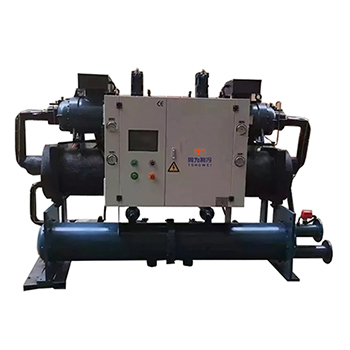Tongwei has the ability to provide chiller machines to suit any application related to anodizing. Type I chromic acid anodizing, Type II commercial anodizing, Type III hardcoat anodizing, titanium anodizing, dipping and chromate anodizing. We can offer packaged chillers, split chillers, or portable chiller systems, providing the flexibility to install in any environment. Portable chillers can also be used if there are several applications in one location that require cooling. Having the benefit of portability can simplify daily process operations.
1.What Is Anodizing?
Anodizing is a chemical process that adds a layer of natural oxides to the surface of metal. The process of forming anodizing comes from the way the chemical coating is performed. The anodized metal sheet terminals the anode in the electrolytic cell.
Which Metals Can Be Anodized?
While aluminum is the most commonly anodized metal, other materials such as magnesium and titanium can also benefit from the anodizing process. While anodizing has its advantages, some materials are not suitable for anodizing. For example, carbon steel corrodes rapidly when exposed to the anodizing reaction.
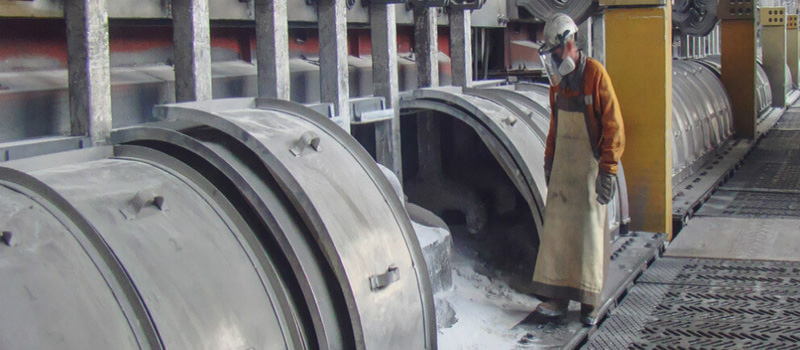
Anodizing Process
2.What is Anodizing Chiller?
Anodizing chillers are uniquely designed cooling machines that effectively remove heat from anodizing and plating processing systems.
Anodizing is a metal finishing process that applies a layer of metal instead of paint to the metal surface. The anodizing chiller removes the heat generated during the electrochemical process through a water-cooled or air-cooled condenser.
Control valves and thermal sensors detect any changes in the temperature of the anodizing process. It has environmentally friendly behavior due to ozone protecting refrigerant. It is known for its ease of installation and maintenance in a variety of applications.
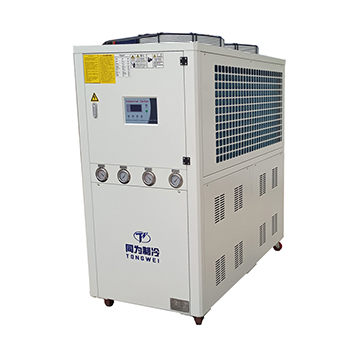
Anodizing Chiller
3.How Does An Anodizing Chiller Work ?
Both air-cooled and water-cooled chiller systems can be installed next to vessels containing electrolytic fluids. The mechanism of cooling is simple. Liquid refrigerant is circulated through the metal finishing cooler and then through a heat exchanger to cool the anodizing process solution. The heated refrigerant is sent back to the chiller to repeat the cycle.
Temperature changes within the anodizing vessel are detected by a thermal regulating device installed inside it. When the heat generated by the anodizing process increases, the regulating valve in the chiller system opens automatically or manually to allow coolant to flow through the heat exchanger and cool the container. When returning to the optimal temperature range, these valves close to avoid overcooling of the electrolysis process.
Another way to regulate anodizing temperature is to use a cooling coil immersed directly in the anodizing solution. While this method is less expensive to install, it has some disadvantages compared to standard anodized cooling systems that use external heat exchangers.
▪ Thermoregulation is less precisely controlled.
▪ The cooling coil may leak, introducing refrigerant into the anodizing vessel, causing contamination and disrupting the oxidation process.
▪ Immersion cooling carries the risk of electrolytic chemical corrosion, which will increase operating costs.
4.Why Need A Chiller For Anodizing &Plating Processing?
As we know, most metal finishing processes, such as anodizing or electroplating, generate a lot of heat. In order to ensure the high quality of the final product, this heat must be dissipated, so the anodizing plating chiller can take advantage of metal finishing. The heat generated during the process maintains the optimal and suitable temperature required for anodizing and plating process.
Anodizing combines with nature to create one of the best metal finishes in the world. This is a process that electrochemically controls, accelerates and enhances the oxidation of aluminum tubes, forming a durable, scratch-resistant coating on the surface. However, temperature control is one of the most important factor during anodizing, electroplating and other metal finishing processes.
5.What’s the Difference Between Air-cooled & Water-cooled Anodizing Chillers?
There are two types of Anodizingchiller: one is air-cooled anodizing chiller ,the other is water-cooled anodizing chiller ;
Air-cooled anodizing chillers use ambient air to dissipate heat from the brewing processes. They are energy-efficient, space-saving, and less maintenance that helps save money.
Water-cooled anodizing chillers use water from an external water cooling tower to dissipate heat from the brewing processes. These systems are longer lifespan, Relatively quiet, and more consistent cooling performance than the air-cooled anodizing chiller.
>
Air-Cooled anodizing Chiller installation
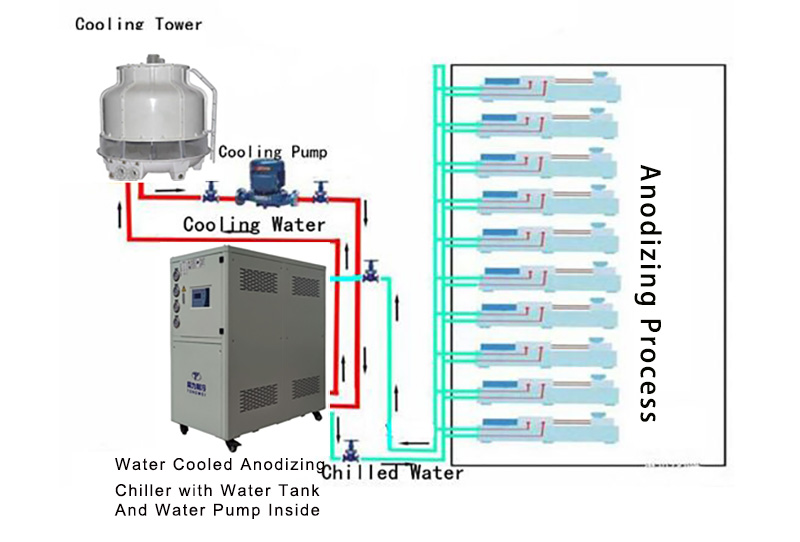
Water-Cooled anodizing Chiller installation
Should you choose an air-cooled or water-cooled Anodizing chiller? Contact Us for help determining the best solution for you.
6.What Are the Differences Between Anodizing Scroll Chiller and Anodizing Screw Chiller?
Anodizing Scroll Chiller Anodizing Screw Chiller
▪1/2 HP-60HP Above 60HP
▪ Danfoss/Panasonic Scroll Compressor Hanbell/Bitzer Screw compressor
▪Built with water tank and water pump Without water tank and water pump
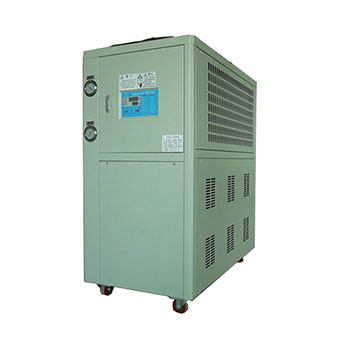
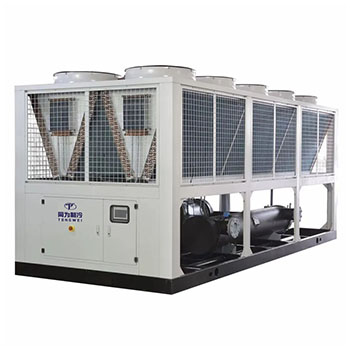
Air-cooled Anodizing Scroll Chiller Air-cooled Anodizing Screw Chiller
Water-cooled Anodizing Scroll Chiller Water-cooled Anodizing Screw Chiller
Based on Constructing Design, the Anodizing Chiller is available as:
▪ Split Chiller
▪Packaged Chiller
7.What Are The Main Components of Anodizing Chillers?
7.1 Compressor
The compressor is the key mover in water chiller because it produces pressure variations to stir the refrigerant around.
From 1/2HP(1/2 Ton) to 60HP(5oTon) anodizing chiller , which is with Panasonic or Danfoss brand Scroll compressor ,
Above 60HP anodizing chiller,which is with Hanbell or Bitzer screw compressor;
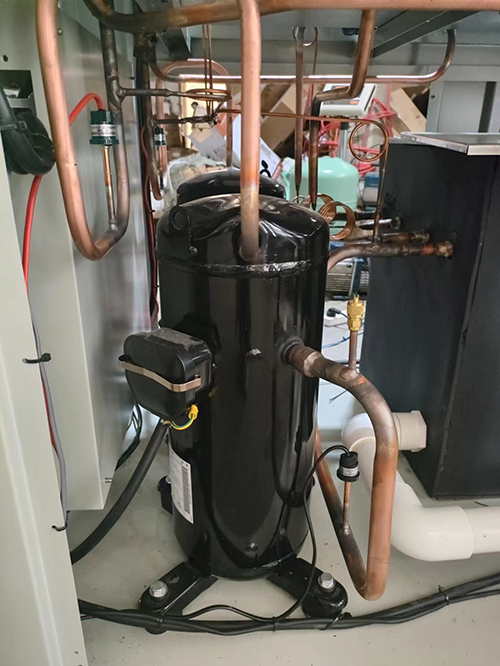 Panasonic Compressor
Panasonic Compressor
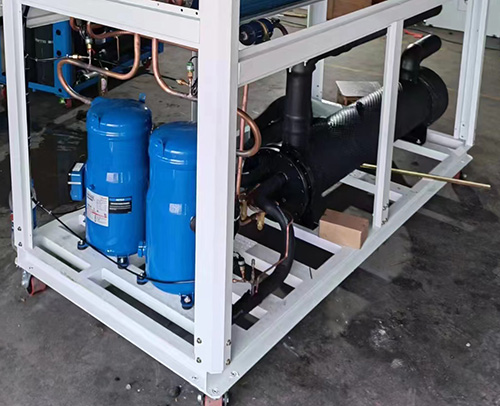
Danfoss Compressor
7.2 Evaporator
The evaporator is a crucial component of air-cooled water chiller, as it is responsible for extracting heat from the liquid being cooled,it is located between the compressor and the expansion valve. There are three types of evaporators : coil in water tank evaporator , shell and tube evaporator, 304SS stainless steel plate type evaporator.
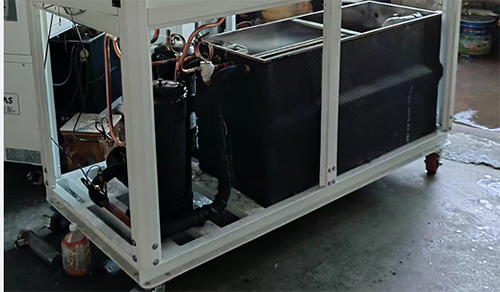 Coil in SS Water Tank Evaporator
Coil in SS Water Tank Evaporator
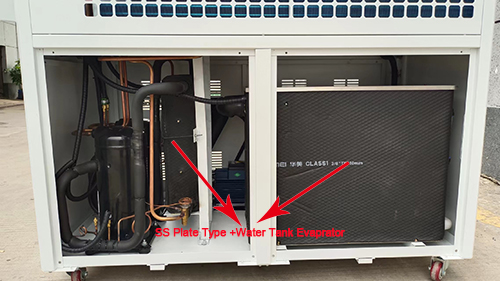
SS Plate Type+ Water Tank Evaporator
7.3 Water Pump
The water pump is designed to increase the pressure and the flow of the chilled water in a closed space.
AnodizingChiller is used with 304 Stainless Steel Water pump.

Water Pump
7.4 Condenser
The condenser for air-cooled Anodizing cooler is equipped with efficient cross-seam fins and female threaded copper tubes for high heat exchange efficiency and good stability.Its function is to cool down the refrigerant steam released from the compressor into a liquid or gas-liquid mixture.
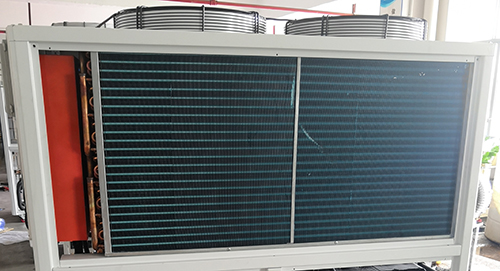
Aluminum fin+fan Condenser for air -cooled Anodizing chiller
The condenser for water-cooled Anodizing cooler is shell and tube ,with the internal copper tubes employing an outer thread embossing process.This design effectively enhances the heat exchange efficiency between the refrigerant and water during the process. Compared to traditional smooth copper tubes, the outer thread embossing process increases the surface area of the copper tubes, thereby expanding the contact area for heat exchange and improving the thermal conductivity of the condenser. This optimization design allows the condenser of the water-cooled chiller to transfer heat from the refrigerant to the water more rapidly and consistently, enabling the water to carry away the heat.
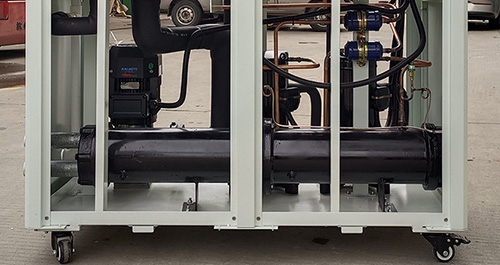
Shell and tube Condenser for water-cooled Anodizing chiller
7.5 Controller Panel
Water chillers use precision digital temperature controller, it RS485 communication port,which can do remote monitoring and control. Simple operation, low failure rate, high safety factor, easy installation.
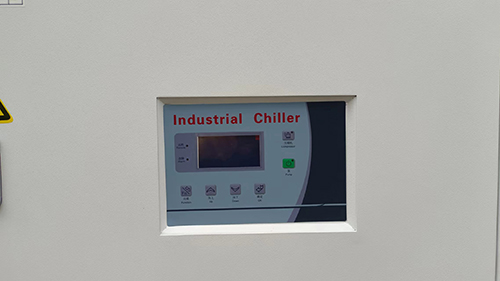
Controller Panel
8. What are the Key Features of a Anodizing Chiller?
▪ Energy-efficient Panasonic/Danfoss/Hanbell/Bitzer compressor
▪ 304 Stainless steel water pump
▪ Chilled 0utlet water temperature control 7℃ to 25℃
▪ Precise temperature controller
▪ Environment-friendly refrigerant R407c/r410a
▪ PID temperature controller
▪ Easy installation ,operation and low cost of maintenance
▪ 304 Stainless Steel Coil in SS water tank /Shell And tube as evaporator
9.What Are The Applications of an Anodizing Chiller?
Anodizing cooling systems are known for their specific temperature regulation capabilities and heat dissipation. Its main applications are as follows:
▪ Laser Cooling
▪ Plating
▪ Anodizing
▪ Impregnation
▪ Powder Coating
▪ Metal Coating
▪ Titanium Anodizing
▪ Quench Cooling
▪ Commercial Anodizing
▪ Spot Welding
▪ Furnace Cooling
▪ Cooling for Induction furnace
▪ Chromic Acid Anodizing
▪Die Casting
Our Anodizing chiller can accommodate other types of equipment as well. If you don‘t have your application here, please contact us for knowing more about.
10.What Are Advantages of an Anodizing Chiller for Your Anodizing &Plating Processing?
Material is anodized for several reasons, to ensure that anodized materials become more durable and long-lasting while expanding the range of applications they can be used for. Listed below are the main reasons why metals are anodized.
Improve corrosion resistance
Materials that will be used in high humidity/water contact environments benefit from anodizing their metal components. For example, ships and hulls, petroleum facility platform superstructures, and terminal equipment all require anodizing to be sufficient to provide a corrosion-resistant coating.
Hardening and Abrasion Control
After metal is anodized, its strength properties can be significantly improved. Unoxidized aluminum (in its non-anodized state) is soft and not suitable for applications that require reinforced components. In contrast, the resulting high tensile strength is valued and used in the manufacture of wear-resistant aluminum alloys.
Equipment Protection
Some industrial processes that emit heat such as anodizing and electroplating processes, are protected from thermal damage. The chilling effect makes electrochemical cells and rectifiers durable by discarding all extra heat.
11.How to Choose Right Anodizing Chiller for Your Anodizing Process?
How to calculate right cooling capacity for your Anodizing chillers?
One of the most frequently ask about how we can know the cooling capacity for chillers.
The range of a chiller at which it can discharge heat from a heated fluid is called cooling capacity.
The cooling capacity of a laser Chiller ranges from 1/2KW to 100KW.
Let’s see the below formula.
Cooling Capacity(kw)= Flow Rate(m3/h)*Temp Change(T1-T2)/0.86
Heat Load= C(specific heat)* M(quality output per hour )*Temp Change(T1-T2)
Oversize the chiller by 20% Ideal Size in KW = KW x 1.2
Noted : T1:Incoming Water Temperature (℃) T2:Required Chilled Water Temperature(℃)
For example, what size of chiller is required to cool 5m³ water from 25°c to 15 °c in 1 hour?
Temperature Differential = 25℃-15℃=10℃
Water Flow Rate = 5 m³/hour
Cooling Capacity in KW = 5 x 10 ÷ 0.86 = 58,14 KW
Oversize the chiller = 58.14 x 1.2 = 69.76 KW
69.96kw cooling capacity for chiller is required.
Types of Anodizingchiller system?
There are two types of chiller :Air Cooled Anodizing Chiller and Water Cooled Anodizing Chiller.
Water cooled chiller needs a separated water cooling tower and water cooling pump ,if you don‘t have exsiting water cooling tower,we suggest you use air cooled chiller; But if your ambiemt temperature is very high above 55℃ ,we suggest you use water cooled chiller , as it is easier to dissipate heat for water cooled chiller with water cooling tower.
But Most customers use air cooled Anodizingchiller ,which is more easily install and save space.
Whether chillers need built-in Tank or not?
In a chiller system, a tank is usually equipped to buffer the thermal load of the chiller.
But should we choose a built-in type of tank or an external type of tank?
A chiller with a built-in tank is easier to install and can be used simply by connecting a water pipe to your application.
But it has a limited capacity and is not suitable for applications with larger chilled water demands.External tank’s capacity can be customized according to specific needs.
It can buffer a larger heat load, store more chilled water, but the installation will be more troublesome.
If you don‘t have external water tank ,we suggest our chiller built-with water tank ,which is easy for you to install.
Cooling capacity unit conversion?
1 KW=860 kcal/h ;
1 TON=3.517 KW;
1 KW=3412 Btu/h;
12.Get a Quote on Industrial Anodizing Chillers Now


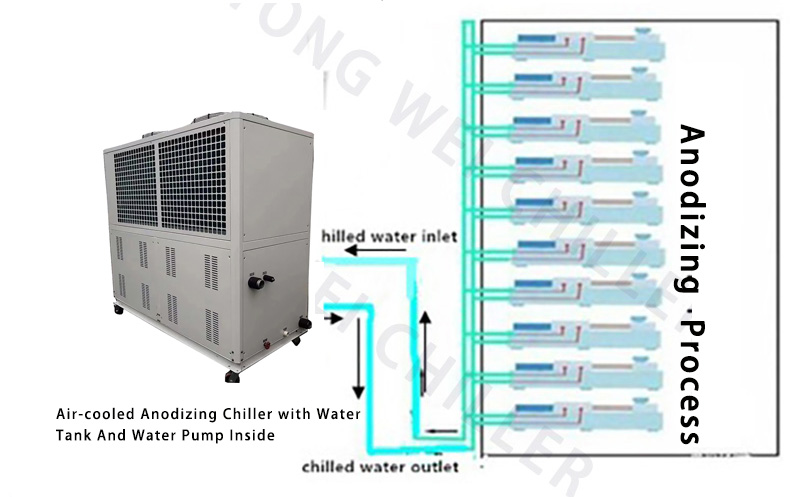













.jpg)
